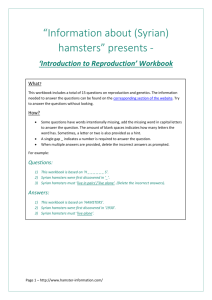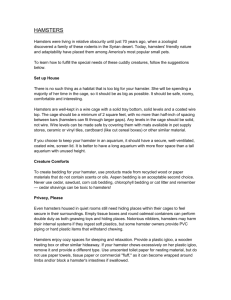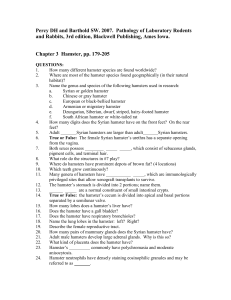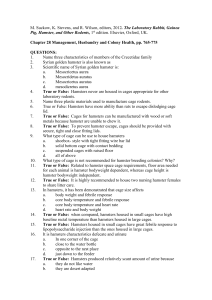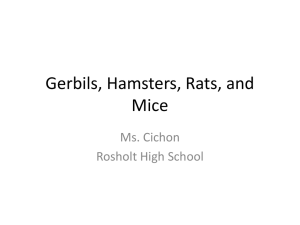Hamster Care
advertisement
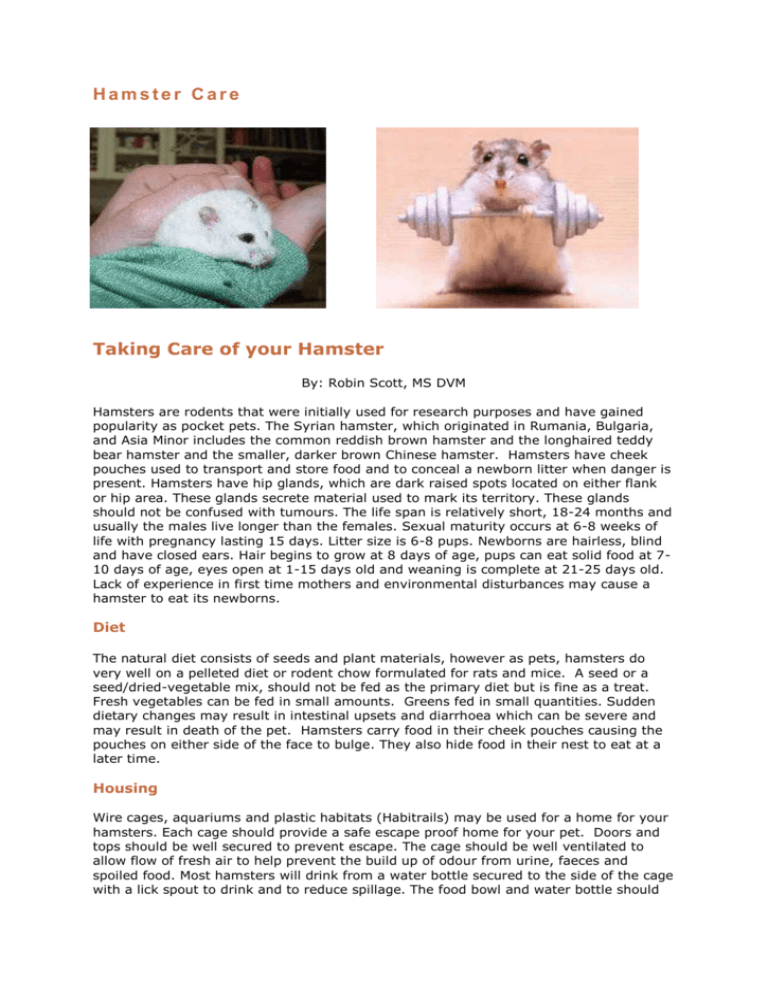
Hamster Care Taking Care of your Hamster By: Robin Scott, MS DVM Hamsters are rodents that were initially used for research purposes and have gained popularity as pocket pets. The Syrian hamster, which originated in Rumania, Bulgaria, and Asia Minor includes the common reddish brown hamster and the longhaired teddy bear hamster and the smaller, darker brown Chinese hamster. Hamsters have cheek pouches used to transport and store food and to conceal a newborn litter when danger is present. Hamsters have hip glands, which are dark raised spots located on either flank or hip area. These glands secrete material used to mark its territory. These glands should not be confused with tumours. The life span is relatively short, 18-24 months and usually the males live longer than the females. Sexual maturity occurs at 6-8 weeks of life with pregnancy lasting 15 days. Litter size is 6-8 pups. Newborns are hairless, blind and have closed ears. Hair begins to grow at 8 days of age, pups can eat solid food at 710 days of age, eyes open at 1-15 days old and weaning is complete at 21-25 days old. Lack of experience in first time mothers and environmental disturbances may cause a hamster to eat its newborns. Diet The natural diet consists of seeds and plant materials, however as pets, hamsters do very well on a pelleted diet or rodent chow formulated for rats and mice. A seed or a seed/dried-vegetable mix, should not be fed as the primary diet but is fine as a treat. Fresh vegetables can be fed in small amounts. Greens fed in small quantities. Sudden dietary changes may result in intestinal upsets and diarrhoea which can be severe and may result in death of the pet. Hamsters carry food in their cheek pouches causing the pouches on either side of the face to bulge. They also hide food in their nest to eat at a later time. Housing Wire cages, aquariums and plastic habitats (Habitrails) may be used for a home for your hamsters. Each cage should provide a safe escape proof home for your pet. Doors and tops should be well secured to prevent escape. The cage should be well ventilated to allow flow of fresh air to help prevent the build up of odour from urine, faeces and spoiled food. Most hamsters will drink from a water bottle secured to the side of the cage with a lick spout to drink and to reduce spillage. The food bowl and water bottle should be cleaned daily and fresh food and water should be supplied daily. Cages should be cleaned at least on a weekly basis. Depending on the size of the cage and the number of hamsters housed in the cage, it may need to be cleaned more frequently. If the cage has an odour of urine or faeces then it needs to be cleaned. Constant exposure of your pet to unsanitary conditions is unpleasant for the pet and can result in infections of the skin, eyes and respiratory tract. Dilute chorine bleach (1 part bleach to 10 parts water), is effective for sanitizing a cage. After cleaning with bleach solution, the cage should be rinsed thoroughly to remove all bleach residue. Do not use cedar or pine shavings as bedding. These woods contain aromatic oils that are very irritating to the skin and mucous membranes of the eyes, nose, throat and lungs. Safe bedding materials include recycled newspaper bedding, aspen shavings, hay and plain white unscented toilet paper or paper towels. Behaviour Hamsters are nocturnal (active at night) and may bite if awakened suddenly. Hamsters do not have good eyesight therefore the owner should always speak to the hamster before picking it up. This gives the hamster some warning that it is going to be touched and reduces the likelihood of you being bitten. The approach from above often triggers a defensive response. The hamster may flip onto its back and try to bite. The teeth are needle like and the bite can be painful, especially to a child. To pick up your hamster, cup your hands around it. Some will nip when picked up no matter what. In these cases, you can use a paper-towel tubes to slide over the hamster, then slide the hamster out the other end onto your hand. Hamsters are nocturnal animals which means they spend a lot of their daylight time sleeping and are more active at night. They enjoy running on an exercise wheel or you may use the clear plastic exercise balls sold for this purpose. DISEASES AND MEDICAL CARE Grooming Hamsters do not require bathing. They should keep themselves clean with self grooming. Occasionally, and especially as they get older, they may require toenail trimming. This toenail over growth can also be a sign of liver disease. Consult your vet if your hamster's toenails suddenly start growing very fast. Some of the longer haired varieties may require combing and trimming of the fur at their rumps. Sniffling, wheezing, sneezing, runny nose These signs are typical of upper respiratory tract (sinus) disease. Common causes include bacterial infections, allergy, irritation due to inhalation of smoke, fumes or odours from cedar/pine shavings. Do not use cedar or pine shavings as bedding. These woods contain aromatic oils that are very irritating to the mucous membranes of the eyes, nose, throat and lungs. Safe bedding materials include recycled newspaper bedding, aspen shavings, hay and plain white unscented toilet paper or paper towels. Hair loss Hair loss may be caused by skin parasites, bacterial infections, fungal disease, and allergic reactions to bedding, in particular cedar/pine chips. Hamsters are very sensitive to the aromatic oils in cedar and pine. Constant contact with these substances can result in hair loss, cracked, dry skin, secondary bacterial infections and in severe cases, death. Wet tail, Diarrhoea, Proliferative enteritis Diarrhoea can result from feeding your hamster a new type of vegetable, an unusually large quantity of fresh vegetables or any sudden change in diet even to a new type of pellet. Long-haired and teddy bear hamsters seem more at risk to develop wet tail. Signs include: matting of fur around the tail, hunched stance, irritability, dehydration, thin, and watery diarrhoea. If your hamster develops diarrhoea after a diet change, stop feeding the new diet item immediately to see if the problem clears up. Regardless of the cause of the diarrhoea, if more than a day passes and your hamster still has diarrhoea, contact your veterinarian. Diarrhoea is a very serious problem. It doesn't take long for a small animal to dehydrate. If your hamster develops diarrhoea after he has been started on any type of medication this can mean that the medication is killing the normal (good) bacteria in the intestine. Contact your veterinarian right away. In many cases, feeding small amounts of live culture yogurt while your hamster is on medication can reduce the chance of this occurring. Diarrhoea can dehydrate and kill a small animal very quickly. Clinical signs of dehydration include: dull, sunken eyes, slow movements, very concentrated urine (dark colour and strong odour) and a skin tent i.e. pinch the skin on the top of the head or the back of the neck-if the skin stays puckered up in a roll and doesn’t quickly flatten out then your hamster is dehydrated. Contact your vet dehydration can be corrected by giving fluids by injection under the skin. Fighting Hamsters can be very territorial and may fight among themselves. This can be a problem when introducing a new hamster to an existing group. In addition, female hamsters may attack their own babies or the babies of another hamster. It is also common for the male hamster to attack its offspring. Female hamsters and their babies should be provided with a nest box or separated from the other hamsters when babies are present. Fighting adults should be separated. Bite wounds can be mild or severe. Any wounds should be cleaned with dilute Betadine (antiseptic solution) and your veterinarian contacted. Do not apply topical antibiotic preparations without first consulting your vet. Some of these products may be toxic to your pet if they are ingested while grooming or cleaning of the wound. Bites from cats or dogs should be considered serious even if they seem mild. Bumps and lumps Cheek pouches filled with food (swelling on either side of the face in the cheek area) may appear as abnormal growths to the casual observer. This is a normal behaviour for your pet. However, hamsters often develop swellings associated with abscess or tumours. These may occur anywhere on the body. Your veterinarian should be consulted for treatment. Pictured above is a hamster with a testicular abscess. This was treated easily with surgery. Dentistry Hamsters, like all rodents, have front teeth (incisors) that grow throughout their life and back or cheek teeth (molars). If the incisors do not wear properly, they may overgrow and cause severe problems as pictured right. Signs of tooth problems include wetness around the mouth, not eating or trying to eat but dropping the food, weight loss, weakness and death. The teeth can trimmed or filed to the appropriate length under anaesthesia at the vets. This must be done every 21-30 days when malocclusion is present. Do not attempt this on your own.

